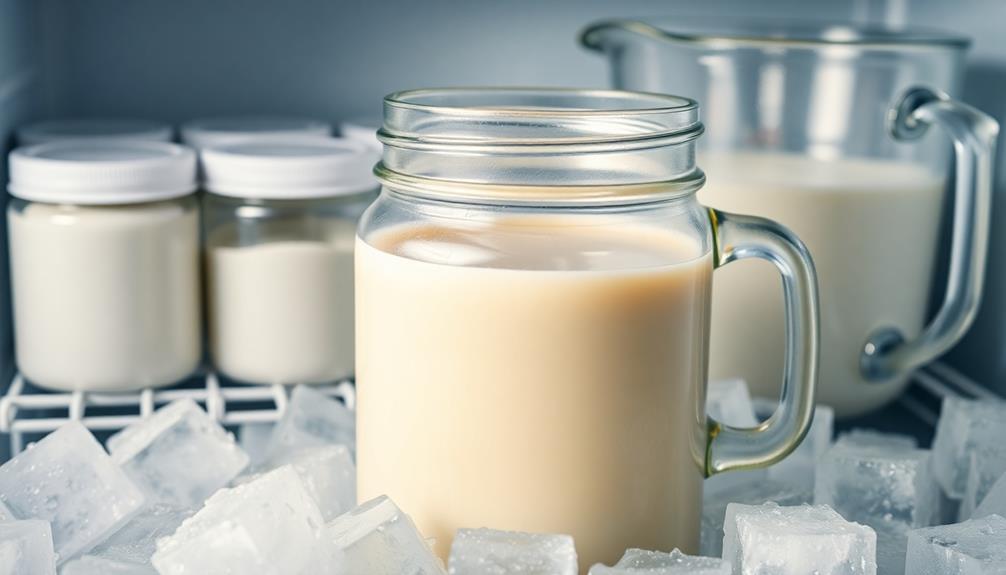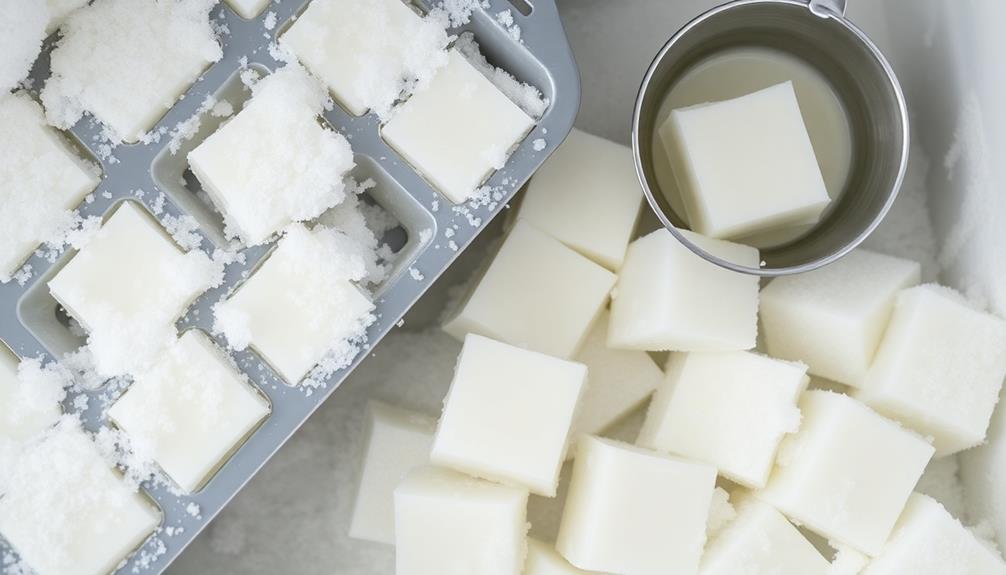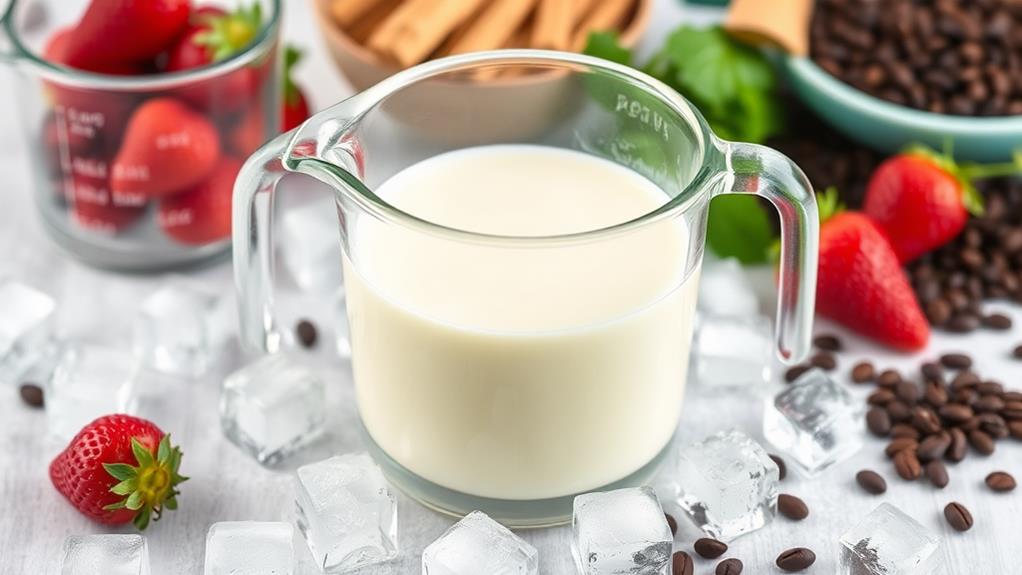Freezing half and half is a great way to extend its shelf life and optimize your groceries. Start by pouring it into sealable containers or ice cube trays, leaving room for expansion. Label each with the freezing date. When you're ready to use it, thaw in the fridge or in a warm water bath, avoiding the microwave. Though thawed half and half may look grainy, a good shake or whisk will restore its creamy consistency. Remember to use it within three days after thawing for best results. You can discover more handy tips and techniques to maximize your grocery savings!
What Is Half and Half?
Half and half is a popular dairy product that combines equal parts of whole milk and heavy cream, giving it a rich and creamy texture with a milk fat content of about 10-12%.
You'll often find it used as a cream alternative in coffee, baking, and cooking, thanks to its ability to enhance flavors while maintaining a lighter consistency than pure heavy cream. With the rise of AI-driven tools that optimize product discovery based on preferences, finding the right half and half for your needs has never been easier.
Whole milk typically contains around 3.25% milk fat, while heavy cream boasts a fat content ranging from 35% to 40%. This unique combination allows half and half to deliver a delightful creaminess without being overwhelmingly rich. If you're feeling adventurous, you can easily whip up your own homemade half and half by mixing equal amounts of whole milk and heavy cream.
This versatile ingredient can elevate various recipes, making it a staple in many kitchens.
Whether you're adding it to your morning coffee or using it in a savory dish, half and half brings a lovely texture that balances richness and flavor.
With its practical uses and easy preparation, half and half is a must-have in your dairy lineup.
Benefits of Freezing Half and Half
Freezing half and half offers several advantages that can make your culinary experience more efficient and cost-effective.
First, it greatly extends its shelf life, allowing you to store it for up to three months without losing flavor. This means you can buy in bulk without worrying about waste, especially when a quart usually costs around $5.79.
Additionally, utilizing budgeting apps can help you track your grocery expenses, guaranteeing that you make the most of your grocery budget.
Using ice cube trays to freeze half and half is a smart strategy. By portioning it out, you ensure that you only thaw the amount you need for your recipes or beverages, minimizing waste.
While thawed half and half may have a grainy texture, it's still perfect for baking, where those texture changes often go unnoticed.
Plus, if you give it a good shake or whisk after thawing, you can restore its creamy consistency, making it suitable for both cooking and drinks.
How to Freeze Half and Half

Freezing half-and-half is simple when you use the right techniques.
Start by transferring it into sealable containers or ice cube trays, making sure to leave space for expansion. This method helps maintain the quality of the product, similar to how expense management apps streamline financial organization.
Once you know how to store it properly, you'll also need to master the thawing process to maintain its quality.
Freezing Techniques Explained
When you're ready to preserve that rich, creamy goodness of half-and-half, it's crucial to use the right techniques to guarantee it stays fresh.
Start by transferring the half-and-half into a sealable container or freezer bag. Be sure to leave about an inch of space at the top to allow for expansion during freezing. To make things even more convenient, you can pour the half-and-half into an ice cube tray. This way, you'll have perfectly portioned amounts ready to use in beverages, sauces, or recipes.
Avoid freezing half-and-half in its original carton to prevent leaks or sogginess. Instead, opt for freezer-safe plastic containers or bags. It's also a good idea to label your containers with the date of freezing so you can track how long it has been stored.
For ideal flavor, aim to use your frozen half-and-half within three months.
Once you're ready to use your frozen half-and-half, remember that thawed half-and-half may separate. Simply whisk or shake it to restore its emulsified texture, making it suitable for all your baking and creamy recipe needs.
Thawing Process Steps
After you've successfully frozen your half-and-half, the next step is thawing it properly.
Start the thawing process by transferring your frozen half-and-half to the refrigerator. This slow method guarantees that the half-and-half, which may separate during freezing, thaws evenly and maintains its quality.
If you're in a hurry, you can also let it sit at room temperature for a quicker thaw, but avoid adding it directly to hot liquids to prevent curdling.
Once it's fully thawed, you might notice some separation. Don't worry—this is normal, especially if you've frozen fat-free varieties.
To restore its smooth texture, simply whisk or shake the container vigorously.
If you've portioned your half-and-half into ice cube trays, you can thaw only the amount you need, making it easier for your recipes or coffee.
Thawing Frozen Half and Half
When you're ready to use your frozen half-and-half, thawing it properly is key to maintaining its quality.
To streamline your kitchen tasks, consider scheduling reminders for grocery inventory and expiration dates to avoid waste and save time, similar to how you'd manage payment alerts and reminders.
You should aim to thaw it in the refrigerator overnight or under cold water for faster results, and always avoid microwaving.
Once it's thawed, give it a gentle shake or whisk to restore its creamy texture before using it within three days.
Best Thawing Methods
Thawing frozen half-and-half effectively is key to preserving its creamy texture and flavor. You have a few reliable thawing methods to choose from, each with its own advantages. Here are the best options:
- Refrigerator Thawing: Place your frozen half-and-half in the refrigerator overnight. This gradual method guarantees an even thaw and keeps the texture intact.
- Warm Water Bath: For quicker results, submerge the sealed container in a bowl of warm water. Just make sure no water enters the container, as it can ruin the half-and-half.
- Avoid Microwaving: Resist the temptation to use the microwave for thawing. It can lead to a grainy consistency, affecting the overall texture.
- Use Promptly: Once thawed, aim to use the half-and-half within three days for peak quality.
Using these thawing methods will help you enjoy your thawed half-and-half in the best condition possible.
Restoring Texture Tips
Once you've successfully thawed your half-and-half, you might notice it looks a bit grainy or curdled. This is a common issue due to separation during freezing. To help restore its texture, try shaking or whisking the thawed half-and-half in a container.
For the best results, gently re-emulsify it by blending in a blender, which can regain that creamy texture you expect.
When using your thawed half-and-half, avoid adding it directly to hot beverages, as this can lead to further curdling. Instead, let it thaw completely in the refrigerator first for better results.
If you find that the texture remains grainy even after these efforts, don't worry. You can still use it in baking, where the texture changes are less noticeable in the final product.
Remember to store your thawed half-and-half in the refrigerator and consume it within three days to keep the flavor and quality intact.
With these restoring texture tips, you can maximize the use of your half-and-half without compromising on taste or texture.
Usage After Thawing
After you've thawed your half-and-half, you'll find it versatile for various recipes. While it may appear grainy or curdled, a good shake or whisk can restore its texture.
To make the most of your thawed half-and-half, consider these usage tips:
- Baking: Use it in baked goods like cakes and muffins. The texture changes won't affect the final product.
- Coffee & Beverages: If you froze half-and-half in ice cube trays, just toss a cube in your coffee or hot chocolate for a quick creaminess boost.
- Sauces & Soups: Thawed half-and-half works well in creamy sauces and soups, but make sure it's completely thawed before adding to avoid curdling.
- Storage: Once thawed, consume it within three days to enjoy the best flavor.
Using Thawed Half and Half

When you use thawed half and half in your recipes, you might notice some separation, but don't worry; a quick shake or whisk can help bring it back together for a smoother consistency.
Thawed half and half is perfect for baking, as the texture changes from thawing are less noticeable in baked goods than when consumed directly. Additionally, you can save on your grocery bills by utilizing digital coupons for purchasing half and half, enabling you to make the most of your grocery budget.
If you want to make your thawed half and half even more convenient, try portioning it into ice cube trays. This way, you can easily add frozen cubes to your coffee or creamy sauces, where they'll dissolve quickly without affecting the dish's overall texture.
Just keep in mind that thawed half and half should be used within three days if stored in the refrigerator to guarantee peak freshness and flavor.
While it's not recommended for direct consumption due to potential graininess, you'll find that thawed half and half works well in cooking applications where texture isn't as critical.
Always check the expiration date before using your thawed half and half to make sure it's still good to go. Happy cooking!
Storage Duration in the Freezer
Freezing half-and-half is a great way to extend its shelf life and minimize waste. While you can technically store it in the freezer indefinitely if it's in a properly sealed container, for the best flavor, aim to use it within three months.
To effectively manage your finances while saving on groceries, consider using tools like expense tracking tools that can help you monitor your spending on food items. Here are some tips to keep track of your storage duration:
- Use a Freezer Bag: Choose a high-quality freezer bag to prevent freezer burn.
- Label Everything: Clearly mark the date of freezing on your container or bag. This helps you track how long it's been stored.
- Check Your Freezer Temperature: Verify your freezer is set to 0°F or lower for maximum preservation of half-and-half quality.
- Monitor Thawed Half-and-Half: After thawing, consume it within three days for the best taste and quality.
Regularly checking your frozen items can help maintain quality and avoid spoilage over time. By following these guidelines, you can enjoy your half-and-half without the worry of waste and guarantee you get the most out of your groceries.
Common Issues With Frozen Half and Half

Commonly, frozen half-and-half presents several issues that can affect its quality. When you thaw it, you might notice separation, leading to a grainy or curdled appearance. To fix this, simply shake or whisk it to re-emulsify the mixture.
However, keep in mind that the texture may still change, becoming less smooth and creamy, which makes it less suitable for direct consumption but perfectly fine for baking or cooking. Understanding the importance of monitoring savings and investments can also help you manage your grocery budget more effectively.
If you add thawed half-and-half to hot beverages without letting it thaw fully, it may curdle due to temperature shock. Consequently, always thaw it completely before use.
It's also worth noting that freezing fat-free half-and-half is particularly problematic. You'll likely encounter undesirable graininess and texture issues, making it unsuitable for most applications.
Lastly, avoid refreezing thawed half-and-half, as repeated freeze-thaw cycles can greatly degrade its texture and overall quality. By being aware of these common issues, you can make the most of your frozen half-and-half and guarantee it works well in your recipes.
Alternatives to Half and Half
If you're looking for alternatives to half-and-half, you've got several options that can easily match its creamy texture and versatility.
Additionally, managing your grocery budget can help you make the most of these alternatives, especially when evaluating top budget apps for beginners.
Here are four great substitutes to explore:
- Whole Milk and Heavy Whipping Cream: Mix equal parts of whole milk and heavy cream. This combination mimics the richness of half-and-half perfectly.
- Light Cream: With about 20% milk fat, light cream can work well in recipes, though it might be slightly less rich.
- Evaporated Milk: For a lower-fat option, evaporated milk offers a similar consistency and is excellent in coffee or cooking.
- Dairy-Free Options: Unsweetened almond milk or oat milk can be good alternatives if you're avoiding animal products, though they may change the flavor of your dishes.
You can also try thinning Greek yogurt with a splash of water or milk to achieve a creamy consistency while adding a unique tangy flavor.
Each of these options provides you with versatile alternatives to half-and-half, ensuring you can still enjoy your favorite recipes without compromising on taste or texture.
Conclusion
Freezing half and half can be a game changer, making sure nothing goes to waste and allowing you to enjoy its creamy goodness whenever you need it. While the journey from freezer to table might come with a few bumps, the rewards are worth it. So, embrace this simple trick to stretch your groceries a little further. With a bit of care, you'll savor the flavors you love, all while keeping your kitchen stocked and your heart light.



